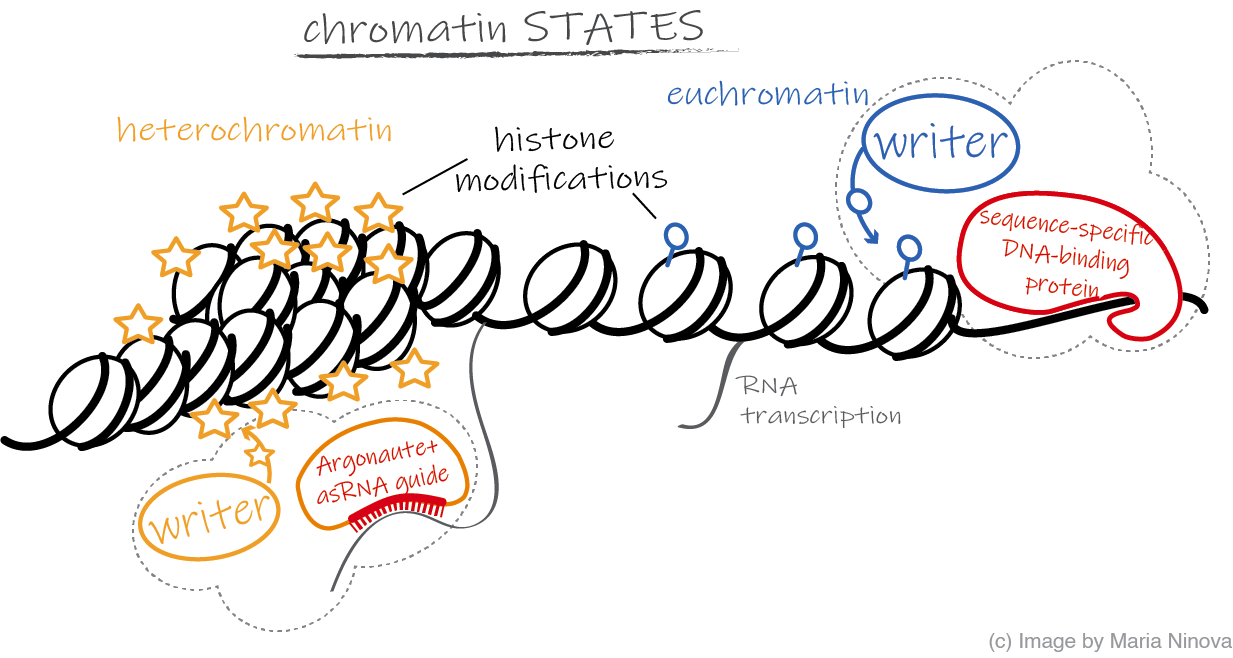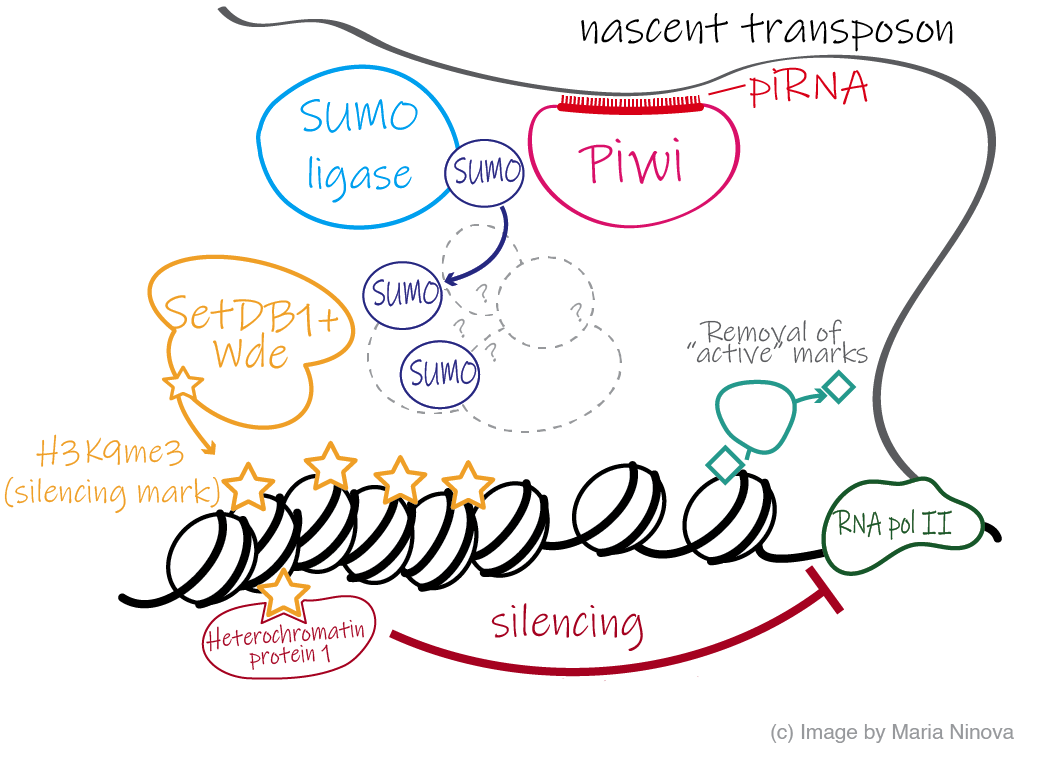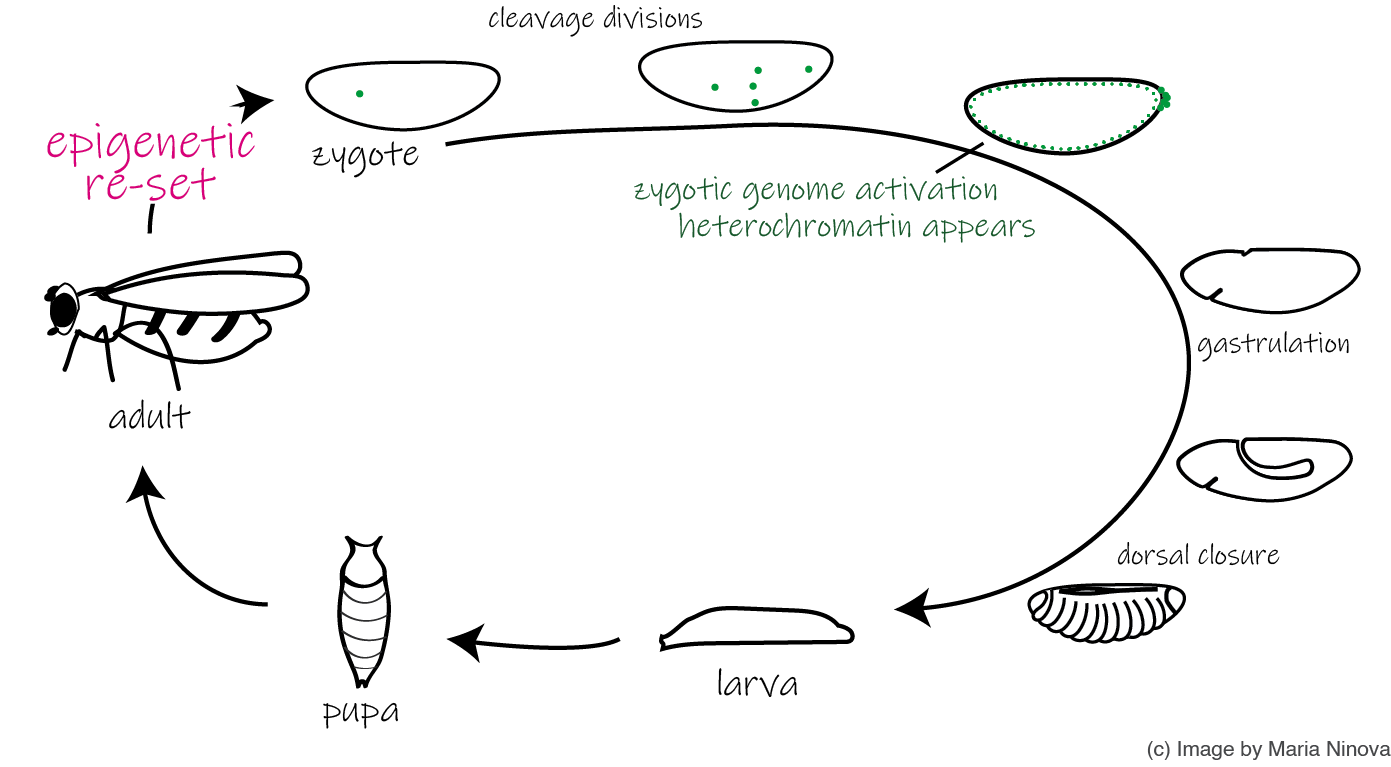Ucr Professor Who Has a Art in a Museum in San Diego
Welcome
Welcome to the laboratory of Maria Ninova, Banana Professor at the Department of Biochemistry, University of California, Riverside. The lab opened on July 1st 2021 and is actively recruiting curiosity-driven and motivated team members interested in epigenetic regulation, minor not-coding RNAs, and transposon control in germ cells and animal development at different career levels, including technicians, undergraduate, graduate, and postdoctoral researchers - click here for more details!
Research
An organism'due south genome contains all the information necessary for its evolution and function, including genes that encode RNA and poly peptide molecules, regulatory regions that coordinate gene activity to form different cells and reply to stimuli, structural regions responsible for the stability, organization and faithful Dna transmission during cell partitioning, as well as "parasitic" elements and regions of no or unknown role. Information technology is essential that this information is organized and switched on and off in a controlled mode, such that but pieces relevant to a specific cell type and function are active at a given time. One of the nearly important ways of genome regulation in eukaryotes is through the association of Deoxyribonucleic acid with histone proteins into a college order chromatin construction.  Post-translational histone modifications can alter chromatin density thereby modulating the accessibility for transcription, and recruit diverse downstream regulatory and structural factors. In principle, targeting specific modifications to appropriate regions can be achieved via different mechanisms involving DNA-bounden proteins or non-coding RNAs that recruit enzymatic "writers". In one case installed, modifications can exist recognized by "reader" factors with diverse regulatory outcomes, and also removed by "eraser" enzymes. Still, nosotros lack detailed understanding of the regulation of unlike chromatin states. Our lab is interested in primal aspects of chromatin regulation such as:
Post-translational histone modifications can alter chromatin density thereby modulating the accessibility for transcription, and recruit diverse downstream regulatory and structural factors. In principle, targeting specific modifications to appropriate regions can be achieved via different mechanisms involving DNA-bounden proteins or non-coding RNAs that recruit enzymatic "writers". In one case installed, modifications can exist recognized by "reader" factors with diverse regulatory outcomes, and also removed by "eraser" enzymes. Still, nosotros lack detailed understanding of the regulation of unlike chromatin states. Our lab is interested in primal aspects of chromatin regulation such as:
- What are the mechanisms that place specific genomic regions for modification?
- How are different chromatin regions outset defined during embryogenesis and then maintained during mitotic divisions?
- What are the biological functions of dissimilar histone marks?
We address these questions by a combiation of molecular biology, imaging, genomics (RNA-seq, Scrap-seq), and proteomics approaches. About of our projects apply the Drosophila melanogaster model organization, which laid the foundations of mod genetics and has been at the frontier of chromatin, piRNA (see beneath), and transposon research. Areas of specific interest include:
The mechanism of piRNA-mediated silencing
 piRNAs are a grade of brusk not-coding RNAs produced in the germline and some somatic tissues of animals that acquaintance with Argonaute proteins from the Piwi clade, and function to recognize and silence transposons - "jumping genes" that can otherwise damage Deoxyribonucleic acid. Defects in the piRNA pathways pb to transposon activation, defects in gametogenesis, and sterility. Remarkably, specific piRNA-loaded Piwi-due south accept the ability to enter the nucleus and induce transcriptional silencing of transposons past recruiting repressive chromatin-modifying factors - a great example of non-coding RNAs triggering epigenetic modifications in animal systems. Recent studies identified several new factors essential for Piwi function. For example, it recently emerged that the SUMO (Small Ubiquitin-Similar Modifier) pathway is required for transposon silencing and repessive chromatin formation at piRNA targets. However, the precise mechanism by which piRNA/Piwi complexes recruit the silencing effectors is not well understood. Our lab aims to use a combination of molecular biology, genomics, and proteomics strategies, to dissect the process of piRNA-mediated silencing.
piRNAs are a grade of brusk not-coding RNAs produced in the germline and some somatic tissues of animals that acquaintance with Argonaute proteins from the Piwi clade, and function to recognize and silence transposons - "jumping genes" that can otherwise damage Deoxyribonucleic acid. Defects in the piRNA pathways pb to transposon activation, defects in gametogenesis, and sterility. Remarkably, specific piRNA-loaded Piwi-due south accept the ability to enter the nucleus and induce transcriptional silencing of transposons past recruiting repressive chromatin-modifying factors - a great example of non-coding RNAs triggering epigenetic modifications in animal systems. Recent studies identified several new factors essential for Piwi function. For example, it recently emerged that the SUMO (Small Ubiquitin-Similar Modifier) pathway is required for transposon silencing and repessive chromatin formation at piRNA targets. However, the precise mechanism by which piRNA/Piwi complexes recruit the silencing effectors is not well understood. Our lab aims to use a combination of molecular biology, genomics, and proteomics strategies, to dissect the process of piRNA-mediated silencing.
Regulation of gene expression by H3K9me3
Heterochromatin was historically identified as the nighttime staining portion of interphase chromatin which remains condensed and is typically (but not always) transcriptionally silenced. Heterochromatin is essnetial for many aspects of cell function and development, such as dosage compensation, lineage-specific gene silencing during differentiation, maintaining the integrity of the repetitive chromosome ends, and repression of transposons. Histone 3 lysine 9 trimethylation (H3K9me3) is a highly conserved hallmark of silencing and heterochromatin that occupies a substantial portion of the eukaryotic genomes and is implicated in the compaction of repeat-rich sequences near centromeres and telomeres, and transposon repreression. In addition, this marking is institute on dozens of host genes and regulatory regions outside constitutive heterochromatin, and appears to play a role in cistron regulation and cell specification. Our lab is interested in gaining a deeper agreement of the biological role of H3K9me3 in different cellular and genomic contexts.

Developmental regulation of heterochromatin
The vast majority of histone and Deoxyribonucleic acid modifications are erased during gametogenesis and fertilization, and need to be re-established de novo in a jail cell-specific mode during the evolution of the new organism. We are interested in the factors and molecular mechanisms that orchestrate the initiation and maintainance of heterochromatin from the zygote throughout embryogenesis using the fruit wing embryo system every bit a epitome.
Master Investigator
![]()
Team
![]()
![]()
![]()
Kun Wu
PhD Rotation Student BCMB
Open up positions
I am looking for motivated individuals at different career levels interested in the lab's scientific areas to join my inquiry team. Available projects use a variety of classic and state-of-the-art approaches, and provide the opportunity to obtain grooming in either or both experimental biology and bioinformatics. PhD and postdoc positions are open up to both US and international (subject area to U.S. visa rules) applicants. Women and underrepresented minorities are encouraged to apply!
Contact me direct with any further questions and to apply. Delight include a short paragraph describing your scientific interests and motivations, resume/CV, contacts of three referees, and if bachelor - an example publication (preprint is fine) reflecting prior work.
Postdocs
Applicants should be near completion or have completed a PhD plan in the following or related disciplines: molecular biology, biochemistry, biophysics, genetics, bioinformatics, and have either substantial easily-on experience with standard biochemistry and molecular biology techniques (such as PCR, Western blotting, poly peptide purification, cloning, etc.), and prison cell culture, or experience in computational analysis of sequencing information and comparative genomics. Experience with Drosophila is a plus, only is not required. We are especially interested in individuals with strong background in biochemistry and proteomics for a NIH-funded postdoctoral position.
Graduate (PhD) students
Applicants must be admitted to one a graduate program at UC Riverside, preferably:
- Biochemistry and Molecular Biology
- Cell, Molecular and Developmental Biology
- Genetics, Genomics and Bioinformatics
Information regarding eligibility criteria, application deadlines (usually in the fall), and awarding process is available on each program'southward website. Many of the projects will involve next generation sequencing (e.g. RNA-seq, ChIP-seq), and are particularly suitable for individuals who wish to obtain a "mixed" training in biological science and bioinformatics. Information technology is not necessary to have prior programming feel, notwithstanding, groundwork in a biology-related discipline is helpful. Prospective students interested in rotating in or joining the lab are encouraged to get in impact with Maria in advance to discuss research opportunities. Co-mentoring arrangements jointly with other PIs are besides a possibility.
Laboratory Assistants/Specialists
We welcome applications for inferior staff positions (laboratory assistant or junior specialist) from individuals interested in taking part in our research. Candidates should accept at least a bachelor'due south degree or equivalent in life sciences and have some prior lab experience. These positions are ideal for recent graduates seeking to gain extra research experience. For inquiries, contact Maria and include [TECHNICIAN] (with the brackets and upper case messages) in the discipline line.
Undergraduates
Undergraduate student research opportunities will become available in the wintertime quarter. Students interested in the lab research areas should contact Maria to discuss potential projects and timelines. Delight include [UNDERGRAD] (with brackets and upper case) in the subject area line.
Contact
About UCR
The University of California, Riverside (UCR) is one of the campuses of the Academy of California system. Hosting over 20,000 undergraduate and iii,000 graduate students, UC Riverside prides itself on being one of America's fastest rising and almost diverse Universities.
The UCR campus is located in the Metropolis of Riverside, part of the Greater Los Angeles metropolitan area. One of the sunniest USA cities, Riverside location provides a rare combination of pocket-size-town experience and proximity to great natural and urban areas: inside most i hour drive (~50 miles) from the Pacific Ocean and popular beaches such as Huntington Beach, mountains (eastward.g. the Big Comport Lake and Ski Resort in the San Bernardino Mountains), downtown LA and Hollywood. It is likewise nigh 1.5-2 hours abroad from Joshua Tree National park, the Santa Monica and Malibu Recreation Areas, the San Diego metropolitan area, and numerous attractions including Disneyland, SeaWorld, Universal Studios, SixFlags, the Getty Museum.
Please check out the UCR website for more information about our campus, customs, and student life.
Source: https://www.ninovalab.org/
0 Response to "Ucr Professor Who Has a Art in a Museum in San Diego"
Post a Comment